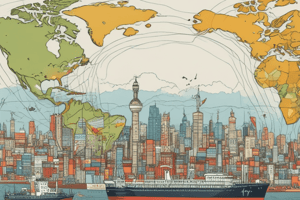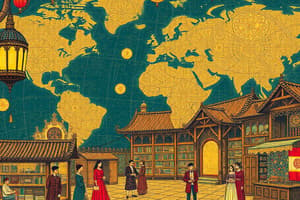Podcast
Questions and Answers
What is the primary distinction between the Global North and the Global South?
What is the primary distinction between the Global North and the Global South?
- Racial inequality (correct)
- Cultural differences
- Economic inequality
- Geographical location
What is a result of the rise of global agribusiness and factory farms in agriculture?
What is a result of the rise of global agribusiness and factory farms in agriculture?
- Increased global food security
- Increased independence of local farmers
- Increased production of staple diets
- Dependence of the South on industrialized food exports from the North (correct)
What are the three urban centers described by Sassen as economic centers that exert control over the world's political economy?
What are the three urban centers described by Sassen as economic centers that exert control over the world's political economy?
- Berlin, Rome, and Sydney
- New York, London, and Tokyo (correct)
- Los Angeles, Chicago, and Miami
- New York, Paris, and Beijing
What is the primary reason for the South's increasing dependence on industrialized food exports from the North?
What is the primary reason for the South's increasing dependence on industrialized food exports from the North?
What is the term used to describe the relationship between the rural and urban areas in the context of globalization?
What is the term used to describe the relationship between the rural and urban areas in the context of globalization?
What is the primary characteristic of a World City?
What is the primary characteristic of a World City?
What is economic globalization, according to the United Nations?
What is economic globalization, according to the United Nations?
What is the main objective of protectionism?
What is the main objective of protectionism?
What is trade liberalization?
What is trade liberalization?
What is the purpose of tariffs?
What is the purpose of tariffs?
What is a result of globalization, especially for developing countries?
What is a result of globalization, especially for developing countries?
What can countries do to make trade easier with other countries while lessening inequities in the global world?
What can countries do to make trade easier with other countries while lessening inequities in the global world?
What are some characteristics of secondary labor market jobs?
What are some characteristics of secondary labor market jobs?
What is a key characteristic of corporations?
What is a key characteristic of corporations?
What is the purpose of international regulatory groups?
What is the purpose of international regulatory groups?
Why are international regulatory groups necessary?
Why are international regulatory groups necessary?
What is a result of international trade agreements?
What is a result of international trade agreements?
Why is international trade important for countries' prosperity?
Why is international trade important for countries' prosperity?
What is a result of innovation and technological growth?
What is a result of innovation and technological growth?
What is the main function of the tertiary sector?
What is the main function of the tertiary sector?
What was the main concern after WW I and II that led to the establishment of the Bretton Wood System?
What was the main concern after WW I and II that led to the establishment of the Bretton Wood System?
How many elements does the Bretton Wood System have?
How many elements does the Bretton Wood System have?
What is the main goal of International Financial Institutions?
What is the main goal of International Financial Institutions?
What is the primary sector responsible for?
What is the primary sector responsible for?
According to Cardoso and Felato, what was the primary influence on Latin American economies?
According to Cardoso and Felato, what was the primary influence on Latin American economies?
What does the concept of dependence refer to?
What does the concept of dependence refer to?
What is the 'core' in Immanuel Wallerstein's Modern World System?
What is the 'core' in Immanuel Wallerstein's Modern World System?
What is neocolonialism in the context of Wallerstein's model?
What is neocolonialism in the context of Wallerstein's model?
What do critics of Wallerstein's theory argue?
What do critics of Wallerstein's theory argue?
What is the 'periphery' in Wallerstein's Modern World System?
What is the 'periphery' in Wallerstein's Modern World System?
Flashcards are hidden until you start studying
Study Notes
Global North and Global South
- The Global North includes the United States, Canada, Western Europe, and developed parts of Asia
- The Global South includes the Caribbean, Latin America, South America, Africa, and parts of Asia
- These distinctions relate largely to racial inequality, specifically between Black and White populations
- Whites are disproportionately in the dominant North, while Blacks are primarily in the South, although this is changing with South-to-North migration
The Global City and Globalization
- Globalization has deeply altered North-South relations in agriculture
- The rise of global agribusiness and factory farms has changed agricultural production relations between the North and South
- The South produces non-traditional products for export and becomes increasingly dependent on industrialized food exports from the North
- This leads to the replacement of staple diets and the displacement of local farmers
- Sassen's concept of global cities describes urban centers that exert control over the world's political economy
- Global cities are categorized based on the global reach of organizations found in them
Economic Globalization and Global Trade
- Economic globalization refers to the increasing interdependence of world economies due to cross-border trade, flow of international capital, and spread of technologies
- There are two types of economies associated with economic globalization: protectionism and trade liberalization
- Protectionism involves government intervention in foreign trade to encourage domestic production and discriminate against foreign competitors
- Trade liberalization involves the removal or reduction of restrictions on the free exchange of goods between nations
- Globalization has led to some countries gaining more in the global economy at the expense of others
- Secondary labor market jobs provide fewer benefits and include lower-skilled jobs and lower-level service sector jobs
Global Corporations
- Corporations are defined as organizations that exist as legal entities with liabilities separate from their members
- Corporations operate across national boundaries, and their future is tied to global economic developments
- International trade has created and been supported by international regulatory groups and transnational trade agreements
International Financial Institutions and Economic Organizations
- International regulatory groups and agreements regulate the flow of goods and services between countries
- These groups reduce tariffs and make customs procedures easier, facilitating international trade
- Market integration is an economic system that organizes production, consumption, and trade in society
- The economy can be divided into three sectors: primary (extracting raw materials), secondary (manufacturing), and tertiary (services)
- International Financial Institutions, such as the Bretton Woods System, aim to restructure the world economy and ensure global financial stability
Dependence Theory and Modern World System
- Dependence theory suggests that less developed countries primarily serve the interests of wealthier countries
- The Modern World System model by Immanuel Wallerstein describes high-income nations as the "core" of the world economy and low-income countries as the "periphery"
- The periphery remains economically dependent on the core in various ways, which tend to reinforce each other (also called neocolonialism)
Studying That Suits You
Use AI to generate personalized quizzes and flashcards to suit your learning preferences.




